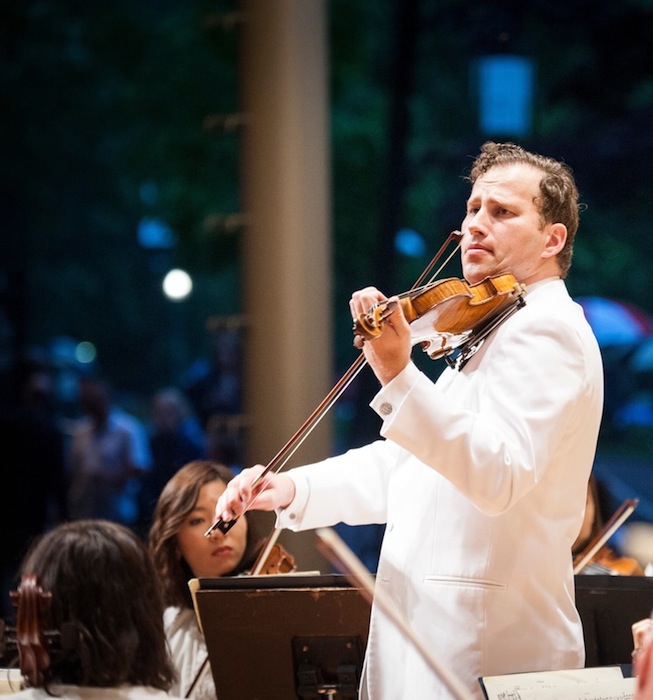It was a dull and stormy night with Znaider’s double-duty Ravinia debut

The soloist/conductor switch-hitter has been a common phenomenon in concert music from the earliest days of ensemble performances. Usually the soloist is a keyboard player, owing to the instrument’s role in early opera and the need for conductors to wield substantial score-reading skills.
Lately it seems that more violinists are trading their bows for batons, although these occasions most often occur in double-duty affairs with Baroque or Classical concertos that are well-known to the personnel and uncomplicated to assemble—-a kind of extension of the chamber music paradigm.
Nikolaj Znaider has set his sights higher than these casual partnerships, making a strong bid to be taken seriously as maestro in orchestral literature from every era and in every degree of complexity. The Danish violinist made his local conducting debut with the Chicago Symphony Orchestra Thursday night at the Ravinia Festival.
Znaider has been fortunate to find some notable backers in his relatively brief journey to the podium. Daniel Barenboim was an early mentor, and Znaider told his Ravinia audience that he dates his passion for conducting to a concert performance led by the former CSO music director of Mozart’s Marriage of Figaro at Highland Park in 2004. He owes his current position as principal guest conductor of the Mariinsky Theatre Symphony Orchestra to the generous support of the orchestra’s music director Valery Gergiev.
Thursday’s concert marked his festival debut as both conductor and violinist, though he has made a strong impression as a soloist on a number of other performances with the orchestra.
Yet even with his breezy rapport with audience members and orchestra musicians, Znaider’s skills as an interpreter of orchestral music seem very much a work in progress.
The concert opened with a lucid, if pale reading of Mozart’s Violin Concerto No. 3. It is difficult for both soloist and audience to see this work by the 19-year-old composer with fresh ears, since we most often hear performances by young players under less-than-optimal circumstances. One could give the violinist credit for not forcing a novel interpretation onto an uncomplicated work, but surely there is more music in this warhorse than he let on.
His intervention in the orchestral introductions and tuttis were minimal to a fault, leading to some ragged ensemble management and lackluster playing. The slow movement contains the concerto’s finest moments, and while he dared to play some phrases with exceptional delicacy, his tonal range was oddly restricted.
Znaider’s reading of Berlioz’s Symphonie fantastique was even more disappointing. The orchestra came to his rescue during passages of high drama and decibels, and Mother Nature added to the programmatic aspects of the symphony with steady rain and occasional flashes of thunder and lightening.
Most annoying was the level of the orchestra’s amplification, a matter of increasingly serious concern in this venue. There was a time when sound re-enforcement within the pavilion was relatively subtle, serving simply to boost the gain for listeners in the back rows on its way to the lawn speakers.
Perhaps emboldened by the large video screen accompaniment, Ravinia’s audio team has lately taken to insinuating themselves into the creative process as well, tweaking balances to such an extent that the mixing board has become a critical arbiter in matters of balance. The violins reached painful levels even when the written dynamic was a mere mezzoforte, and when the piccolo joined them, more than a few audience members employed finger-to-ear mediation.
But even with these caveats, one expected a more compelling version of Berlioz’s colorful warhorse. With no visible score as reference, and considering his background as a thoughtful musician, there could be little doubt about his fluency with the music at hand. Yet his interpretation was generally stilted and unilluminating, betraying a literal allegiance to the score but with seemingly little personal involvement.
Berlioz’s score gave listeners a chance to evaluate principals during an era of unprecedented upheaval in CSO personnel. While many areas of concern remain, it was a pleasure to hear new principal bassoonist Keith Buncke take to the score’s difficulties with impressive dexterity and musicality. The conversation between oboist Michael Henoch and English horn player Scott Hosteler in the “Scene in the Country” was touching, though Znaider would have done well to encourage more flexibility.
It was up to the brass sections to elevate an otherwise ordinary performance into a memorable experience with gleaming accounts of the final two movements. If nature’s contributions were closer to the violence of the fourth movement of Beethoven’s “Pastoral” Symphony than the gentle and distant timpani rumblings in Berlioz’ fourth movement, the mismatch was an apt reflection of a musical collaboration than never quite jelled.
Posted in Performances





Posted Jul 17, 2015 at 3:19 pm by Deborah
Mr. Cameron’s criticism of Ravinia pavilion’s amplification is well founded. However, I don’t agree that the interpretation of Berlioz’ masterwork was “dull” for it was anything but that. I understand that Mr. Cameron is speaking from the viewpoint of a professional critic whereas I am a mere amateur listener and lover of program music. Though not presently at a Muti or Conlon experience level, Mr. Znaider shows great promise in his love of conducting, and in this debut has demonstrated to me that he has a fine and long future ahead.
Posted Jul 18, 2015 at 7:58 am by Laurie
You had me at “The orchestra came to his rescue…”. Thank you, Mr. Cameron, for making this point in print. So often, the conductor gets the credit for a good performance and the orchestra takes the blame for a bad one when in reality, the group is working very hard to maintain their level of excellence despite what is happening on the podium.